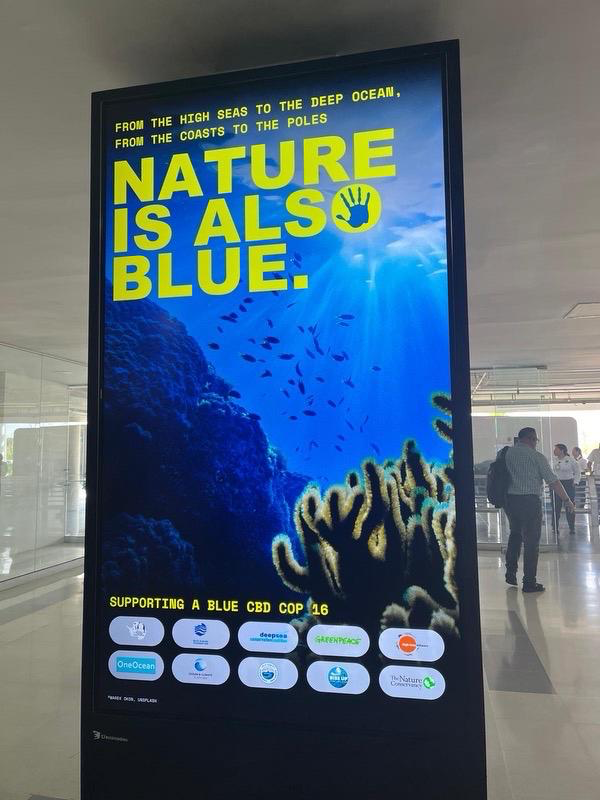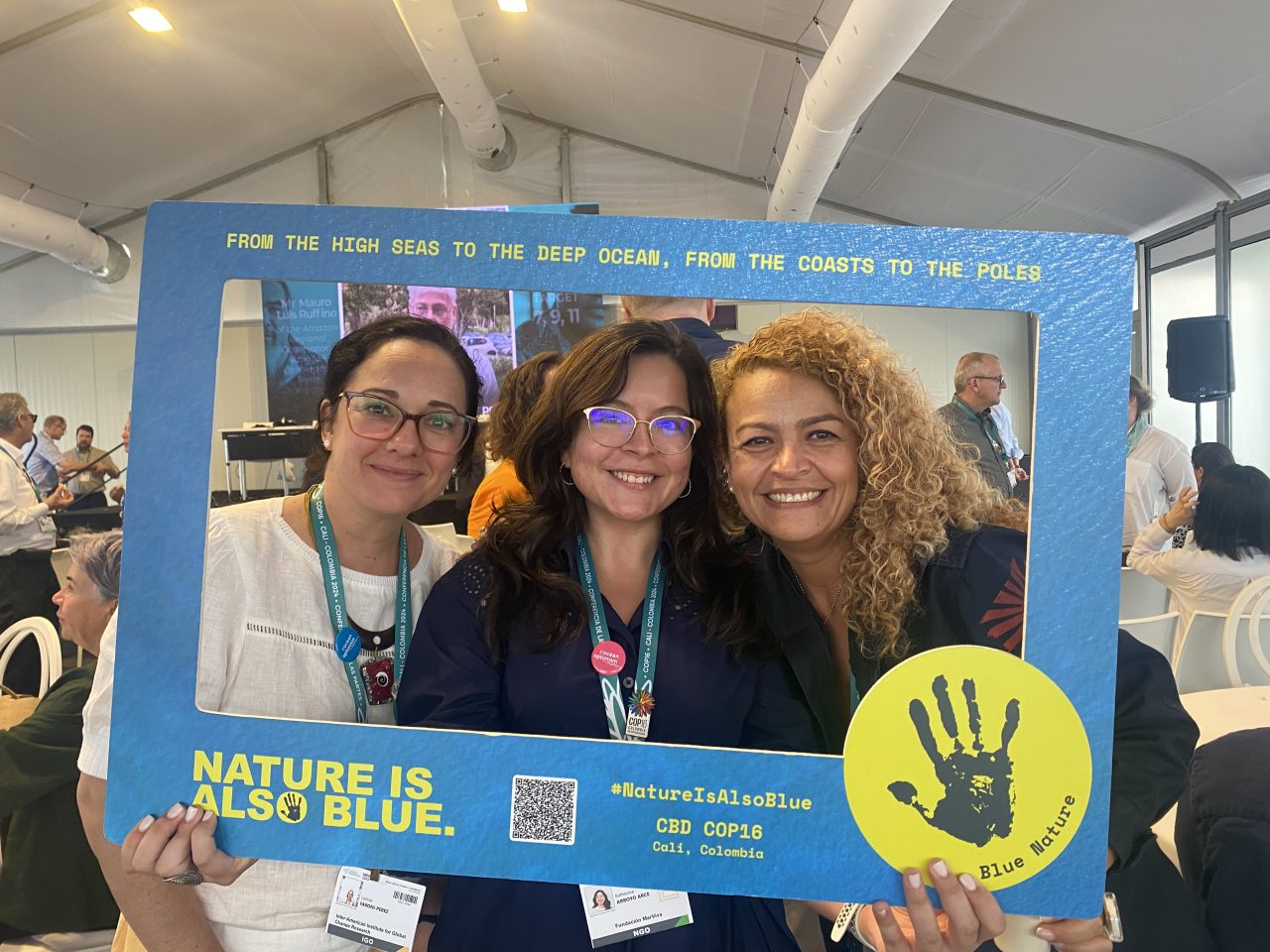As COP16 in Cali, Colombia, concluded on November 1, the “Nature Is Also Blue” campaign left a lasting impression on the conference, both within the negotiations and outside, underscoring the essential role of marine ecosystems in planetary health and in global biodiversity protection efforts. The ocean community championed “Nature Is Also Blue” as a rallying call to remind world leaders of the ocean’s indispensable contribution to achieving the Kunming-Montreal Global Biodiversity Framework’s goals.
Nature Is Also Blue: Amplifying the Ocean’s Voice

The “Nature Is Also Blue” campaign brought a unique energy to COP16 through a series of impactful visual symbols, events, and digital engagement strategies:

- Cali Airport and Venue Activations: Visitors arriving in Cali were greeted by 83 screens displaying striking visuals of ocean biodiversity. These displays set the tone for the campaign, emphasising the importance of marine conservation from the moment delegates and attendees entered the city.
- Blue Handprint Symbol: Displayed around the conference venue, these handprints served as a reminder of our collective responsibility to protect the ocean, uniting delegates, NGOs, and advocates around a shared commitment to marine conservation.
- Blue Wristbands: Delegates and attendees wore blue wristbands to show solidarity, signalling their support for ocean protection throughout the event.
- Ocean Day Events: Ocean Day, celebrated on October 27, featured a series of events that emphasised the importance of the ocean. Through presentations, performances, and discussions, attendees highlighted how protecting marine biodiversity is essential for achieving a nature-positive future.
- Global Social Media Engagement: Advocates and organisations worldwide joined the campaign using the hashtag #NatureIsAlsoBlue, driving over 1,200 mentions and 49,000 engagements. A digital toolkit equipped supporters to spread awareness, helping #NatureIsAlsoBlue reach over 5 million potential impressions and expand its impact far beyond the conference venue.
Key COP16 Ocean Outcomes
The conference achieved some important outcomes for the ocean. Notably, COP16 adopted a new process for updating Ecologically and Biologically Significant Areas (EBSAs), which guides the identification of key ocean regions that require protection. This scientific framework will empower decision-makers to prioritise the identification of areas that should be protected both within national waters and on the high seas, aligning with the goal to protect 30% of the ocean by 2030.
Additionally, COP16 strengthened synergies between the Kunming-Montreal Global Biodiversity Framework and the High Seas Treaty (BBNJ) which will help promote a unified approach to safeguarding ocean biodiversity.
A significant outcome of COP16 was the establishment of a Subsidiary Body for Indigenous Participation. This body will formally include Indigenous peoples in future conservation decisions, acknowledging their essential role in protecting biodiversity. This step reflects a growing recognition of Indigenous knowledge and leadership in environmental stewardship, ensuring that conservation efforts benefit from their deep understanding of marine ecosystems.
Another big breakthrough at the meeting, following hours of negotiations extending into the next day, was on a new multilateral mechanism on the rules governing access to digital sequencing information (DSI) on genetic resources. Given the interlinkages with the DSI benefit-sharing obligations of the High Seas Treaty, this will be something to follow closely on how it will be developed and implemented to ensure they are mutually supportive.
At COP16, blue carbon ecosystems—such as mangroves, seagrasses, and salt marshes—were prioritised for their role in biodiversity and climate resilience. Commitments were made to restore these habitats, which store carbon, support marine life, and protect coastal communities. The conference also emphasised sustainable aquaculture, urging countries to adopt restorative practices and reform harmful subsidies, paving the way for more biodiversity-friendly food systems.
Looking Forward: Next Steps for Ocean Conservation
Despite the urgency of the biodiversity crisis being stressed throughout the conference, it was very disappointing that countries ran out of time and the meeting was suspended before agreement could be made on other key issues such as resource mobilisation that will be absolutely critical to achieve the Global Biodiversity Framework’s targets.
This lack of agreement should make us only strengthen our resolve as the ocean community to look to further opportunities to make progress. COP29 in Baku from 11-22 November will be the next critical step. COP29 will provide an opportunity to advance the integration of ocean and climate agendas, underscoring the ocean’s essential role in both biodiversity and climate resilience. By emphasising a “blue” perspective across these events, the ocean community can ensure that marine conservation remains a priority within global conservation and climate frameworks, paving the way for sustained, impactful action for the ocean.
A Lasting Message: Nature Is Also Blue
“Nature Is Also Blue” remains a powerful reminder that comprehensive biodiversity protection must include our ocean. By highlighting the ocean’s essential role in a nature-positive future, this campaign has brought new urgency and focus to marine conservation, ensuring that ocean health is integrated into global biodiversity and climate resilience and adaptation efforts.
The “Nature Is Also Blue” campaign was made possible through the support and collaboration of leading environmental organisations, including the Antarctic and Southern Ocean Coalition, Blue Marine Foundation, Deep Sea Conservation Coalition, High Seas Alliance, Greenpeace International, The Nature Conservancy, Ocean & Climate Platform, Oceans North, and RISE UP. We extend our heartfelt thanks to these partners and to everyone who engaged with the campaign, amplifying its message and helping to make ocean biodiversity a priority at COP16.




